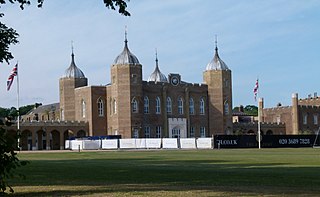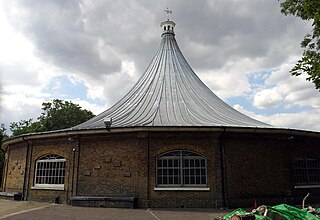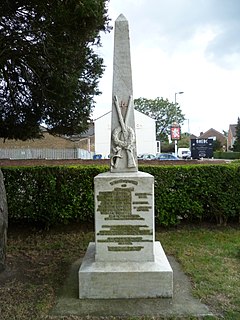Albert Toft was a British sculptor.

The Royal Military Academy (RMA) at Woolwich, in south-east London, was a British Army military academy for the training of commissioned officers of the Royal Artillery and Royal Engineers. It later also trained officers of the Royal Corps of Signals and other technical corps. RMA Woolwich was commonly known as "The Shop" because its first building was a converted workshop of the Woolwich Arsenal.

The Royal Artillery Memorial is a First World War memorial located on Hyde Park Corner in London, England. Designed by Charles Sargeant Jagger, with architectural work by Lionel Pearson, and unveiled in 1925, the memorial commemorates the 49,076 soldiers from the Royal Artillery killed in the First World War. The static nature of the conflict, particularly on the Western Front, meant that artillery played a major role in the war, though physical reminders of the fighting were often avoided in the years after the war. The Royal Artillery War Commemoration Fund (RAWCF) was formed in 1918 to preside over the regiment's commemorations, aware of some dissatisfaction with memorials to previous wars. The RAWCF approached several eminent architects but its insistence on a visual representation of artillery meant that none was able to produce a satisfactory design. Thus they approached Jagger, himself an ex-soldier who had been wounded in the war. Jagger produced a design which was accepted in 1922, though he modified it several times before construction.

Woolwich Common is a common in Woolwich in southeast London, England. It is partly used as military land and partly as an urban park. Woolwich Common is a conservation area. It is part of the South East London Green Chain. It is also the name of a street on the east side of the common, as well as an electoral ward of the Royal Borough of Greenwich. The population of the ward at the 2011 Census was 17,499.

The Royal Artillery Museum, which was one of the world's oldest military museums, was first opened to the public in Woolwich in south-east London in 1820. It told the story of the development of artillery through the ages by way of a collection of artillery pieces from across the centuries. The museum had its roots in an earlier institution, the Royal Military Repository ; items which were once displayed in the Repository form the nucleus of the Royal Artillery Museum collection. Following the closure in 2016 of the museum, branded since 2001 as 'Firepower – The Royal Artillery Museum', its collection has been placed in storage pending the establishment of a new Royal Artillery Museum. The Royal Artillery Museum collections are designated as being of national and international significance by Arts Council England.

The Royal Army Veterinary Corps (RAVC), known as the Army Veterinary Corps (AVC) until it gained the royal prefix on 27 November 1918, is an administrative and operational branch of the British Army responsible for the provision, training and care of animals. It is a small corps, forming part of the Army Medical Services.

The Royal School of Artillery (RSA) is the principal training establishment for artillery warfare in the British Army. Established in 1915, it is located at Larkhill, Wiltshire, on the south edge of Salisbury Plain in the United Kingdom. The School is the primary training facility for Royal Artillery recruits, and is also home to the Gunnery Training Team.

Larkhill is a garrison town in the civil parish of Durrington, Wiltshire, England. It lies about 1+3⁄4 miles (2.8 km) west of the centre of Durrington village and 1+1⁄2 mi (2.4 km) north of the prehistoric monument of Stonehenge. It is about 10 mi (16 km) north of Salisbury.

Sir George James Frampton, was a British sculptor. He was a leading member of the New Sculpture movement in his early career when he created sculptures with elements of Art Nouveau and Symbolism, often combining different materials such as marble and bronze in a single piece. While his later works were more traditional in style, Frampton had a prolific career in which he created many notable public monuments, including several statues of Queen Victoria and later, after World War I, a number of war memorials. These included the Edith Cavell Memorial in London, which, along with the Peter Pan statue in Kensington Gardens are possibly Frampton's best known works.

Major General Hugo Douglas de Pree, was a British Army officer who served as Commandant of the Royal Military Academy, Woolwich.

Artillery Memorial, Cape Town was erected in memory of the gunners who fought for South Africa during World War I. The memorial, which forms part of the Delville Wood Memorial, is located in the Company's Garden, Cape Town, and was strategically established to commemorate South Africa's artillery soldiers who fell in battle. Of those who volunteered to fight during the war, 5800 were white South African, amongst whom 15% were Dutch and 85% English. An estimated 2536 of these men were killed in the Deville Wood battle in Europe. The Artillery Memorial, an authentic cannon facing east towards the National Gallery, proudly honors South Africa's heavy artillerymen. Inscribed on it are the names of the officers, N.C.O.'s and men of the South African artillery who fell in the Great War (1914–1918).

Eastney Barracks was a military installation occupied by the Royal Marines and located at Eastney near Portsmouth.

St George's Garrison Church is a ruined church in Woolwich in the Royal Borough of Greenwich, South East London. It was built in 1862-63 as a Church of England place of worship for the Woolwich Royal Artillery garrison. The church was hit by a V-1 flying bomb in 1944 and largely destroyed by fire. The restored ruin with its canopied roof, its blue, red and yellow brick walls, its mosaics and a memorial garden is open to the public on Sundays.

The Barnet Boys School Boer War Memorial is located opposite Christ Church on the St Albans Road in Chipping Barnet, London. It marks the deaths of the eight former pupils of Barnet Boys School who died in the Second Boer War of 1899 to 1902 and was unveiled by Field Marshal Lord Grenfell in July 1903. It has been grade II listed on the National Heritage List for England since June 2017. The heritage listing describes the monument as "simple yet dignified".

The Royal Artillery Boer War Memorial is located on the south side of The Mall in Central London, close to the junction with Horse Guards Road at the northeast corner of St James's Park. Unveiled in 1910, it marks the deaths of the 1,083 soldiers of the Royal Artillery who died in the Second Boer War from 1899 to 1902 It has been a listed building since 1970.

The Garrison Church of St Alban the Martyr is a Church of England church in Larkhill, Wiltshire, England.

Royal Artillery Barracks, Woolwich, is a barracks of the British Army which forms part of Woolwich Garrison. The Royal Regiment of Artillery had its headquarters here from 1776 until 2007, when it was moved to Larkhill Garrison.
Francis William Doyle Jones, sometimes Francis William Doyle-Jones, was a British sculptor. Although principally a portrait sculptor, Jones is notable for the number of war memorials he created for British towns and cities following both the Boer War and World War I.

















